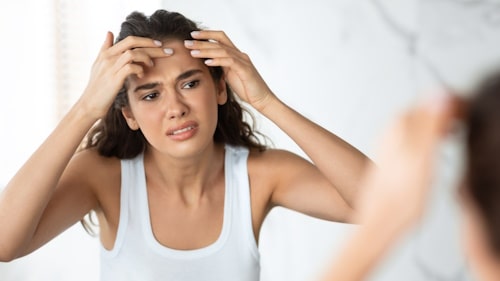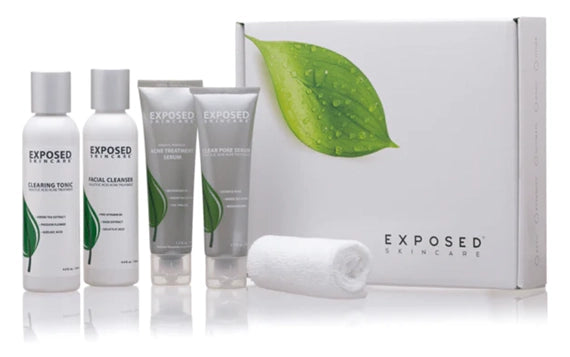Yes, low estrogen can absolutely trigger acne, especially those painful jawline cysts. When estrogen drops during your period or perimenopause, your oil glands go into overdrive while your skin gets drier (worst combo ever). Regular acne products just can't handle this hormonal mess. Exposed's multi-action system tackles both the surface issues and deeper hormone-driven problems, with most users seeing real improvements within weeks. Stick around to discover your complete hormone-balancing routine.
Biggest Takeaways
- Low estrogen levels trigger acne by increasing sebum production and inflammation, often appearing as cystic bumps along the jawline.
- Hormonal fluctuations during menstrual cycles, pregnancy, or menopause can disrupt skin balance and cause predictable breakout patterns.
- Traditional acne products like benzoyl peroxide target surface issues but don't address underlying hormonal imbalances.
- Low estrogen creates drier skin that paradoxically leads to oil overproduction as sebaceous glands attempt to compensate.
- Exposed Skin Care's multi-action approach targets hormonal acne by addressing both surface symptoms and deeper hormonal factors.
The Connection Between Low Estrogen and Acne Breakouts

While you may have blamed chocolate or your sweaty workout for those stubborn breakouts, the real culprit might be hiding in your hormones.
So does low estrogen cause acne? In a word: absolutely.
When your estrogen levels drop—whether during your period, pregnancy, or approaching menopause—your skin pays the price. Low estrogen triggers your oil glands to pump out excess sebum (that's skin grease for the rest of us) and cranks up inflammation.
Estrogen crashes, skin suffers—more oil, more inflammation, more acne along your jawline.
The result? Those deep, painful cystic bumps that love to camp out along your jawline.
What's worse, when estrogen dips, you're losing the hormone that helps maintain collagen and skin moisture. Your skin gets drier and more sensitive, creating the perfect storm for stubborn breakouts that laugh at your expensive face wash.
How Hormonal Fluctuations Trigger the Four Acne Drivers
When your hormones go on a rollercoaster ride, they don't just mess with your mood—they're triggering all four acne drivers simultaneously. Low estrogen levels let androgens run wild, cranking up your sebum production like nobody's business. Hello, oil slick!
This hormonal chaos doesn't stop there. Your menstrual cycle becomes a monthly breakout countdown, with inflammation flaring right before your period hits.
Stress? It's pouring gasoline on the fire by spiking cortisol levels, further throwing your hormones out of whack.
The real kicker? When estrogen drops, your skin might dry out—which counterintuitively makes your oil glands panic and overproduce, clogging pores faster than you can say "Why me?"
It's not just one thing going wrong—it's your entire skin ecosystem rebelling at once.
Identifying Low Estrogen Acne: Key Signs and Symptoms

How exactly can you tell if those stubborn breakouts are tied to your estrogen levels taking a nosedive?
Look for those deep, painful cystic pimples that set up camp along your jawline and chin—basically the signature calling card of hormone-related acne.
If your breakouts sync up with your cycle or have suddenly appeared during perimenopause (you're not alone—15% of women in their 50s are dealing with this same drama), low estrogen might be the culprit.
The plot thickens when your skin also feels unusually dry and sensitive despite the oil slick happening elsewhere.
This hormonal rollercoaster doesn't just trigger one acne driver—it cranks up inflammation, oil production, and pore-clogging all at once.
No wonder those single-ingredient spot treatments aren't cutting it!
Why Traditional Acne Products Fall Short for Hormonal Breakouts
Traditional acne washes and spot treatments might as well be shooting blankets at a tank when it comes to hormonal breakouts.
Your trusty benzoyl peroxide and salicylic acid products? They're just surface-level solutions trying to fight a deeper battle.
Here's the deal: while these ingredients might kill bacteria and unclog pores, they're clueless about the hormonal chaos happening beneath your skin.
When estrogen levels drop, your body's androgen hormones throw a wild sebum-production party that no face wash can shut down.
It's like using a band-aid for a broken bone. These products weren't designed to regulate the hormonal imbalances driving your breakouts.
That's why you can follow a perfect skincare routine and still wake up with that stubborn chin acne every month like clockwork.
Exposed's Multi-Action Approach to Hormonal Acne

Unlike those one-trick-pony acne products, Exposed Skin Care actually gets the whole hormonal acne mess you're dealing with. When your estrogen tanks and those chin zits pop up, you need more than just a spot treatment.
Exposed tackles hormonal breakouts from multiple angles—combining salicylic acid to unclog those stubborn pores with benzoyl peroxide to calm the angry inflammation. It's like having a skincare squad that understands your hormone drama.
What's cool is how their system works on both the surface stuff and the deeper hormonal chaos. No BS promises—just a solid routine that thousands of women swear by for taming those monthly eruptions.
Plus, they back it with a satisfaction guarantee because they're not just throwing random ingredients at your face and crossing their fingers.
Your Complete Morning-to-Night Routine for Balancing Low Estrogen Acne
When your estrogen levels hit rock bottom, your skin freaks out in ways that basic spot treatments just can't handle. You need a strategy that tackles all four acne drivers, not just a quick fix.
Start your morning with Exposed's Facial Cleanser—it uses salicylic acid to unclog pores without stripping your already-compromised moisture barrier.
Follow with the Clearing Tonic to rebalance, then apply the Daytime Acne Serum where benzoyl peroxide and tea tree oil kill bacteria while green tea extract controls oil production.
At night, double-cleanse, then apply the Clear Pore Serum to work overnight on stubborn clogs.
Always finish with a non-comedogenic moisturizer—your skin needs hydration even when it's freaking out.
This consistent routine targets every aspect of low-estrogen acne, not just the symptoms everyone else is treating.
Real Results: How Exposed Users Cleared Their Hormonal Acne
Countless women struggling with low estrogen acne have ditched their medicine cabinet full of failed products after switching to Exposed.
These aren't just fluffy testimonials—users consistently report dramatic improvements within weeks, not months.
Real results, real fast—women see visible acne clearing in weeks instead of endless waiting.
"I tried everything for my hormonal breakouts until I found Exposed," shares one reviewer. "The combo of salicylic acid and benzoyl peroxide actually worked when nothing else would."
What sets these results apart? Unlike one-trick-pony products that temporarily mask symptoms, Exposed tackles all four acne drivers simultaneously.
The system addresses both surface issues and underlying hormonal triggers without the crazy price tag of dermatologist visits.
Best part? You're not gambling on yet another empty promise—their one-year guarantee means they're actually confident you'll join the clear-skin club.
No more wasting money on hyped-up failures.
Frequently Asked Questions
How Does Low Estrogen Affect Acne?
Low estrogen disrupts your hormonal balance, triggering excess oil production and inflammation. This imbalance leaves androgens unchecked, creating the perfect storm for stubborn breakouts that frustrate you and fellow acne-sufferers daily.
What Does an Estrogen Imbalance Feel Like?
When hormones go haywire, you'll notice your body sending signals. You might experience mood swings, irregular periods, hot flashes, sleep troubles, and skin changes including frustrating acne breakouts.
What Happens to Skin When Estrogen Is Low?
When your estrogen drops, your skin gets drier, oil production increases, and inflammation rises. You'll notice more breakouts, slower healing, and reduced collagen leading to thinner, less elastic skin.
Will Increasing My Estrogen Help My Acne?
Like a dried riverbed that cracks and overcompensates, your skin may respond to increased estrogen with fewer breakouts. You'll likely see improvement, but you'll need a complete system to target all acne drivers.
Putting It All Together
You're not imagining it—those breakouts when your estrogen dips are totally real. A whopping 65% of women report acne flares during hormonal shifts. But here's the deal: targeting hormones alone is like bringing a knife to a gunfight. Exposed's system tackles all four acne triggers simultaneously, not just the hormonal chaos. Skip the one-trick solutions and give your skin what it actually needs—comprehensive protection against those monthly rebellions.



















